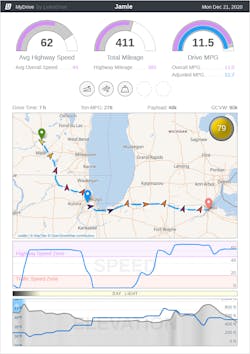It doesn’t matter if a fleet is just starting out or has been operating for decades—they all want the same thing: more. More safety, more efficiency, and more uptime. And to achieve these goals, a fleet owner needs at least some data. Luckily, this is the era of digital transformation, where connected trucks and telematics devices are the norm, generating more data than most fleets know what to do with.
That’s a good problem to have, as all the real-time data streaming from engines and sensors and cameras can be analyzed and distilled into a potent formula for success, according to the experts who participated in a recent CV Tech roundtable titled “Safety through telematics.”
The session was fully loaded with advice on how any fleet can leverage data into actionable insights.
“You have to look at the practical issues of having all that data,” Mike Degeneffe, vice president of driver experience and telematics at Schneider National, said. “More is better in terms of our perspective, but you have to be able to consume the data. If it’s just noise—if you can't transform that into impactful information—then it doesn't have value.”
Schneider was ranked ninth on the FleetOwner For-Hire 500, with about 12,000 tractors and 34,000 trailers. The fleet has been on the bleeding edge of driver/ops communication since at least 1988 when it began using Qualcomm two-way satellite devices and co-developed its current tablet-based telematics solution with Platform Science.
“We really want to have a productive driver and help them to deliver on our freight, and so all the tasks that they have to do, from pickup and delivery steps between all that is managed through a dynamic workflow capability, is communicated to drivers,” Degeneffe said. “None of that would be of any value if we didn't have it integrated for back-end systems.”
The open architecture allows Schneider to customize and sort for relevant data, such as engine and safety system data, to improve real-time communication with drivers and coach them if alerted to unsafe behavior, such as hard braking events. Pre-trip, it allows the fleet to have an omniscient view of its asset utilization, including trucks, trailers and containers, and if they are full or empty. Schneider also shares road data with its navigation provider to detect problem areas such as improper roll stability.
Being able to find the right provider and solution was far easier for Schneider than most fleets, considering its size and experience. Degeneffe noted Schneider asset data goes right through its own system, but smaller fleets will likely have to work with their provider’s fixed platform that provides analysis in the cloud, selecting which system offers the most safety and efficiency benefits for their operation.
“One size fits nobody, so when you look in the marketplace for solutions, you usually have a list of features that you want to compare each solution against, and then oftentimes you have to compromise,” he said.
Small but efficient
For fleets on the smaller side, a concerted effort into managing relevant telematics data can result in relatively large gains. Such is the case with Hellbent Xpress. In 2010, owner Jamie Hagen was a one-man show, though his self-professed obsession with efficiency allowed his fleet to grow to six Mack Anthems, which will rise to nine when the latest order is fulfilled.
Hagen, who has been driving commercially for nearly 30 years and knew how crucial it was to control fuel and maintenance costs, spec’d a Mack truck with the Super Econodyne downspeeding package. Downspeeding promotes fuel efficiency by configuring the transmission to speed up the rear gear ratio to lower the engine speed and reduce friction.
“That's what set me on the path here to excellent fuel economy that slowly worked its way into extreme profitability and made me think that maybe I could do it again with a second truck,” Hagen recounted during the discussion. “I bought a second truck in 2017, which led to a third truck in 2018— just slowly taking the profits from one to help build another.”
With more trucks on the road, he was able to invest in a telematics solution called PedalCoach by LinkeDrive.
“It basically monitors your fuel and where you're traveling, just a bunch of information to really help you narrow down how you drive but also the other mitigating factors in your driving,” Hagen said. “The more we dug into it, the better it got.”
Screenshots from LinkeDrive’s MyDrive portal that Hagen displayed showed he was able to achieve an overall mpg of 11 and adjusted mpg of 11.7. The portal also breaks down average speed into overall and highway, and does the same with mileage. This is a crucial insight into fuel projections, as it shows even if a driver sets the adaptive cruise control to 70 mph, the overall average is 55 due to starts and stops and traffic. Data on elevation, daylight and temperature, which affects fuel efficiency, are also included for optimal fuel usage visibility.
Hellbent also employs the FuelGauges app by Let’s Truck for historical fuel data.
“There are only so many things within your control, but there are things you can improve upon,” Hagen said.
Hagen also started improving driver morale by gamifying the data to incentivizing his team’s efficient driving with better pay.
“I couldn't be in the cab with them, but with this thing in the truck, I could tell what was going on,” he said.
Digital eye on safety
Incremental improvements in fuel usage pale in comparison to how much can be saved by exploiting a truck’s safety system data. That’s because you can’t put a price on a lost life, though juries levying nuclear verdicts, punitive damages that can exceed $10 million (or much more) because of a truck crash, sure do try.
Avoiding such tragic events is a major reason why HERE Technologies, which sponsored the CV Tech session, developed its location and route planning solution for commercial vehicles. Some of the data points include restrictions for bridge and tunnel heights, hazardous goods, and axle and weight limits. It also includes locations on rest stops and available parking, which a dispatcher can use to direct a fatigued driver or one nearing their hours of service limits to find a safe haven.
“We're looking fundamentally at post-trip analysis, at being able to observe driver behavior over time and provide richer data that helps fleet managers make informed decisions about the overall safety of their fleet operations,” said Alex Osaki, marketing manager at HERE.
He said analysis of past accidents and where they occurred can prevent future ones.
“It's impossible to really understand the cause of accidents and to assess your driver performance without being able to provide the context, without understanding all of the things that go into any particular route,” Osaki said. “Being able to provide answers to these by making the map computational, by bringing together location intelligence into one place, that allows these questions to be answered can provide a dramatic impact.”
Those context clues include the time of day, weather conditions, road surface, and road curvature. Osaki said applying that location data and safety technology can reduce fatalities up to 70%.
Osaki also added those insights provide more visibility into a driver’s day-to-day operations and potential risky behavior, such as exceeding the speed limit. And safe driving data could be shown to insurance handlers to lower premiums.
“You can then make a strong case that you dramatically improved the safety of your fleet in these ways,” Osaki sad. “Being able to provide metrics to that is really significant.”
About the Author
John Hitch
Editor
John Hitch is the editor-in-chief of Fleet Maintenance, providing maintenance management and technicians with the the latest information on the tools and strategies to keep their fleets' commercial vehicles moving. He is based out of Cleveland, Ohio, and was previously senior editor for FleetOwner. He previously wrote about manufacturing and advanced technology for IndustryWeek and New Equipment Digest.


